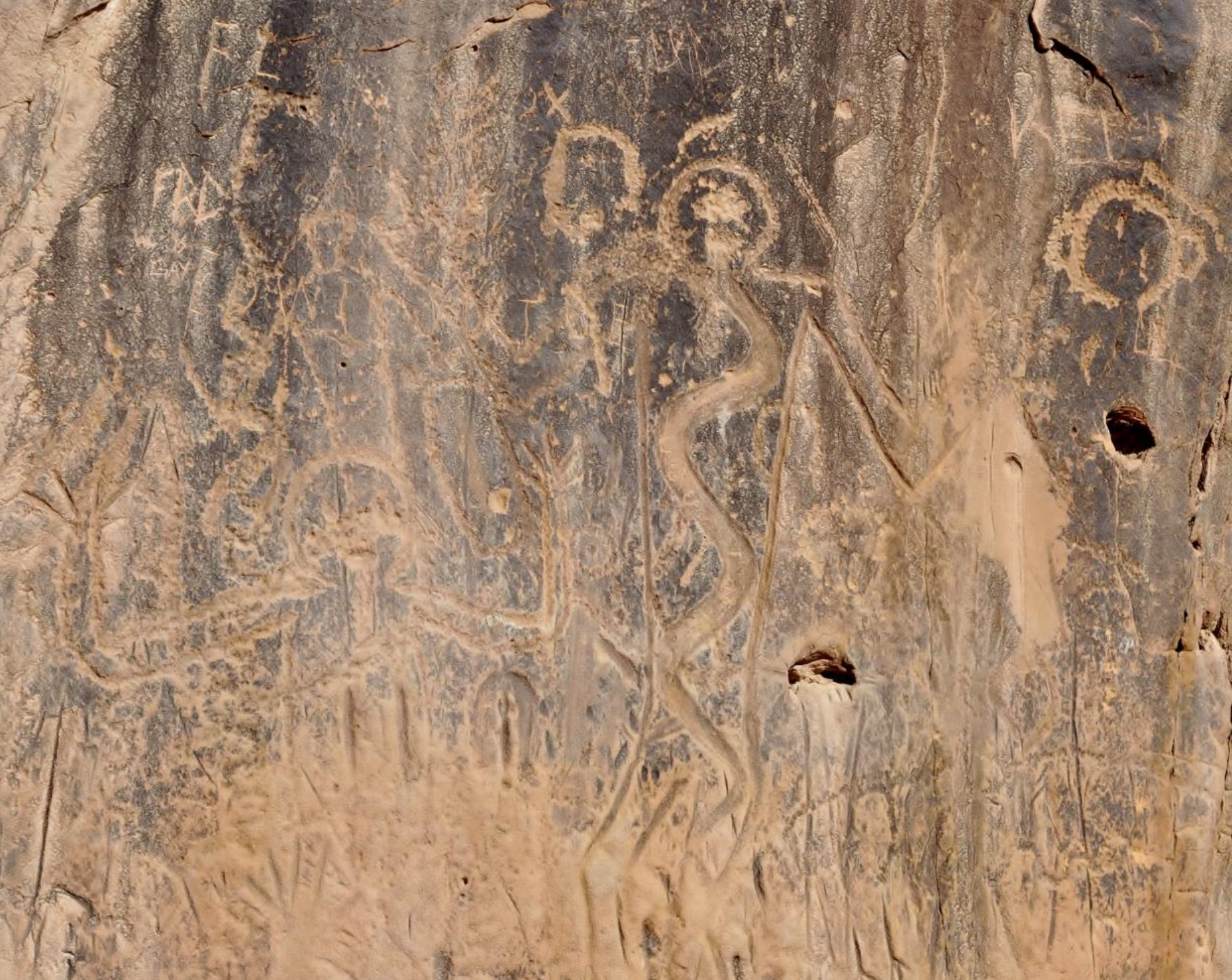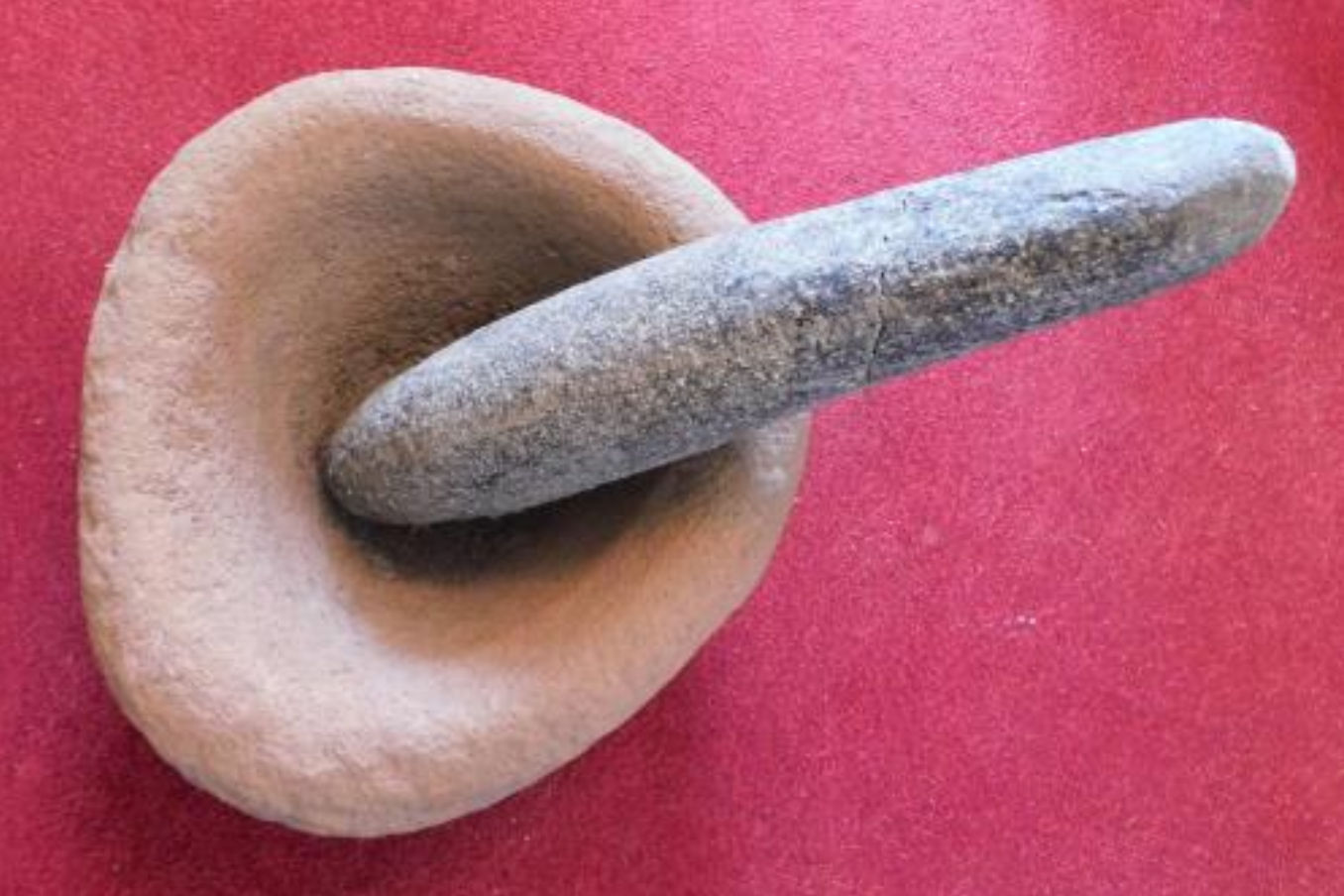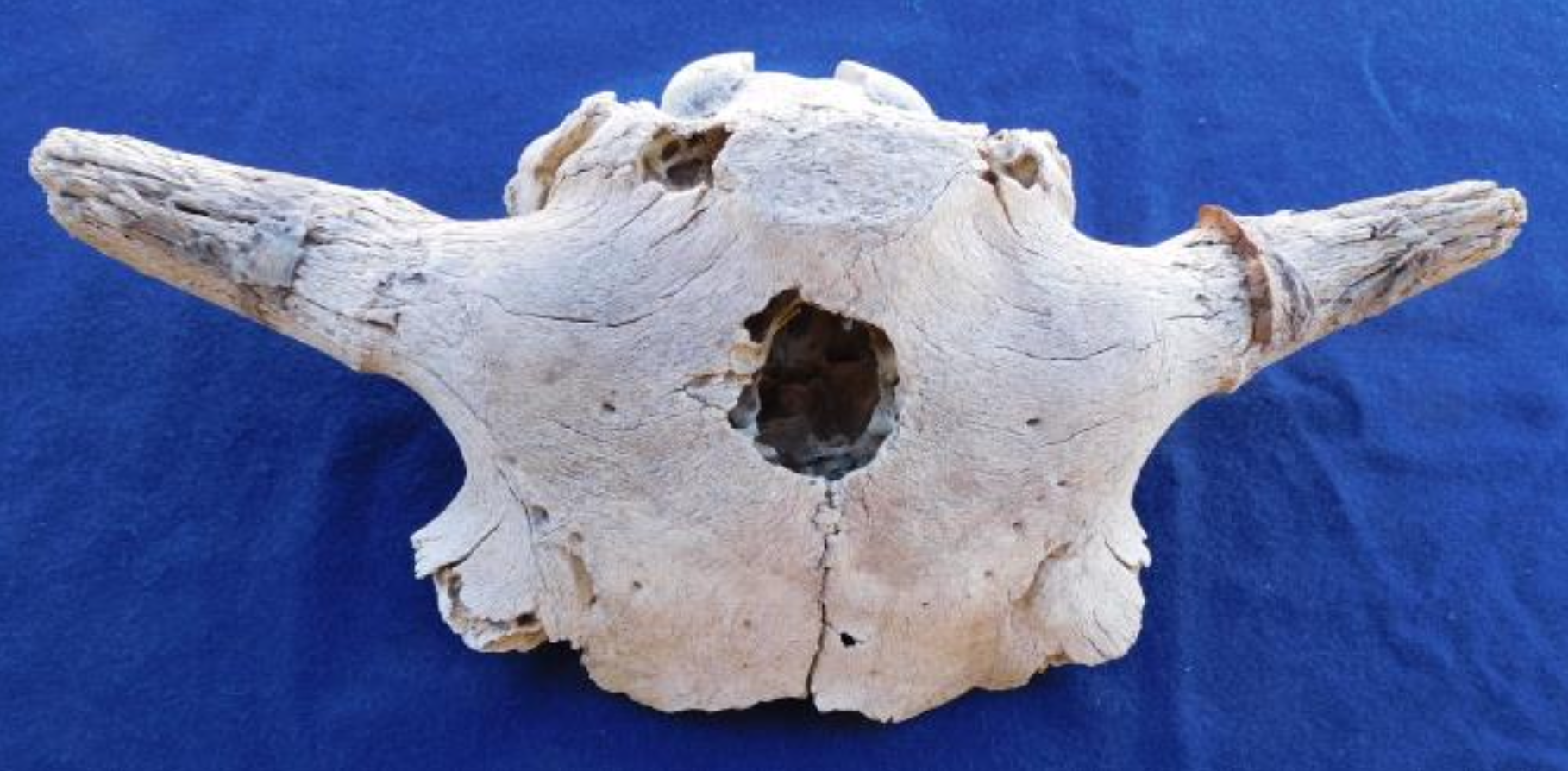Over two thousand years ago, Paleo-Indians came to the Black Hills, known as Paha Sapa by the Lakota Sioux. This article is focused on ancient religious petroglyph and pictograph images scratched into a rock wall, along the Cheyenne River, 12 miles south of Hot Springs, South Dakota on property of the Wild Horse Sanctuary (IRAM).
These early Native Americans hunted numerous animals in the area and grew a corn type developed in Mexico with 3 to 4-inch ears, along with beans and squash beans by the Cheyenne River. Family groups numbering 40 to 60 individuals lived here, using a rock opening in the petroglyph wall and a huge overhang with an active spring. Using buffalo hide tipis allowed them mobility through the region to hunt game. Hundreds of tipi rings are in the area, consisting of heavy and flat stones used on the inside of the tipi so poles would not move inward by high wind—also to secure an inside hide liner for warmth. To pull the tipi poles and transport goods, these pedestrians used a husky-type dog. These same dogs helped carry meat from nearby kill sites to their village.
The abrasive rock of the petroglyph wall provided an ideal surface to shape and sharpen bone and stone tools by rubbing objects on the sandstone surface. Most groove lines are from years of shaping and sharpening bone awls, that show as narrow, straight lines on the canyon wall. Awls served to poke holes for sewing with sinew threads. Other bone and stone tools were roughly formed by chipping and pecking, then rubbed for hours or days against the grit of this sandstone wall. Often in boredom, the worker shaped their work into an interesting design.
Knapping punch, shoulder blade knife, awl, spade, hair pin, flesher for tanning, horn core scoop
The adjacent Cheyenne River provided considerable game which used this valley to travel around the Southern Hills. About 1,500 years ago the bow became a common weapon for hunting. (Examples on my Museum page show imbedded arrowheads in bones.) Many of the early animals were larger than species today, such as antiquus buffalo, almost 7 feet tall at their hump. Animals found here were not especially fearful and could be approached for hunting. Game included deer, giant short-faced bears, bighorn sheep, elk, giant beaver and mammoths. A day’s walk from the petroglyphs were 120 hot springs which Paleo Indians used for healing. Here over a hundred Columbian mammoths were recently discovered that died in a sink hole, known as The Mammoth Site. From another location, a Clovis spear point was found with mammoth bones, to know these early people hunted very large mammals.
These people were highly intelligent and skilled at various tasks. They were precise at stone-knapping, creating an Angostura point, uncovered at a waterfall on the Cheyenne River, now part of Angostura Reservoir. This diagonally-flaked, small spear point was effective at penetrating thick hides of large animals, using leverage of an atlatl spear thrower rather than a wider and longer hand-held, larger Clovis-point spear. The material for stone-knapping was only an hour’s climb to a mountain top known as Flint Hill. The stone is not flint, but rather quartzite, a metamorphic sandstone. Hundreds of deep pits, many ten feet deep and twenty feet across, were quarried to work by percussion and pressure-flaking their stone points, knives and stone grinders.
Angostura, Clovis and long spear point next to ceremonial knives
This valley was heavily farmed by the early Paleo Indians, later by Kiowa and Cheyenne, indicated by approximately two hundred quartzite grinders found in the petroglyph vicinity (shown below). The top and bottom stones were used for daily grinding corn into a fine powder. This corn meal was flattened like a taco shell and baked upon hot rocks. Cleverly, they knew to add a small pinch of ash to aid digestion. For most uses, the cooking of meat was accomplished using the large stomach of a buffalo, cleaned of the contents. Dropping a half dozen hot stones into the paunch filled with water, the contents would be cooked in less than an hour. Tripe soup, called menudo by some, is still a delicacy among the Lakota Sioux. The stomach lining offered necessary nutrients to the diet. After eating the soup, the stomach itself was eaten the second day.
Grinding top and bottom stones used to crush and grind corn into powdery meal
Droughts are not new to the area. The rock wall was studied in 1980 by SDSU, and they learned petroglyphs on this cliff continue another ten to twelve feet below the present ground level. This indicates the earliest people fashioning their tools were standing below existing ground level. During periodic droughts when Indians were farming here, sandy soil blew against this wall to raise the level of the ground. Ceremonies to appeal for rain were conducted by early people shown by two men with upraised arms, fingers spread, and rattlesnakes carried in their mouths. Long ago, and still practiced in the Southwest, rattlesnakes are believed associated with the Thunder Being (Wakinyan in Lakota Sioux) to bring rain, when appeased. Rattlesnakes move with a zig-zag motion, representing Lightning.
Side and top view of three celts
Celts were a stone tool used as a chisel and wedge in woodworking (shown above). They may have been sharpened here, and in the process, formed the curved snake outlines.
There are five faces of men pecked into the rock, each with a top knot of hair. These may represent Wiwila, powerful Little People, believed to live in water and capable of causing rain, when appeased in ceremonies. The full body of men are shown naked with widespread fingers in a supplication prayer. One man holds a shield in his right hand, snake in his mouth and drum in his left hand.
A common story told among tribes is that long ago there was a Great Flood which covered the entire world, destroying all life, except for several good people that were spared. This is much like the Noah account in Genesis. Signs of this devastating flood are on mountain tops of the Seven Sisters with fossilized animals such as turtles, clams, squids and petrified trees. In the valley by the Sanctuary is a tropical cycad palm forest, fossilized by the waters of a world flood. These numerous fossils were explained by Paleo, and later Lakota medicine men, as evidence that long-ago were fierce battles between the above ground land creatures and the underwater creatures, their bodies turned to stone
Larry Belitz showcasing the Cheyenne Canyon Petroglyphs
Buffalo leg bone to poke holes for planting, spade, hoe and preserved Paleo corn cobs
Found near the petroglyph is this sandstone pestle and mortar to pound corn kernels and a petrified buffalo head whose brains were removed for tanning hides
Photograph of a 1905 Snake Dance by Hopi Indians in the Southwest. Rattlesnakes are gathered from four directions, then held in the mouths of dancers praying for rain. Following the dance, snakes are released to bring rain. Note zig-zag lines on the back of dancers.
During a long, dry period, with little game and no crops, the early Paleo-Indians moved south to become cliff-dwellers of Colorado and the Southwest. Around 1776, the Sioux arrived in this area, shown on their winter count calendar with a drawing of a pine tree. A pictograph (shown below) of a captured horse may be the work of a Lakota Sioux, who drew on their winter count, that in 1812 they caught their first wild horses.
This rock cliff is a National Treasure. It has unique images not present on other cliffs, indicating this was considered a sacred area. The Wild Horse Sanctuary has the honor to be entrusted with the protection of this site.
By Larry Belitz, Plains Indian Material Culture Consultant













